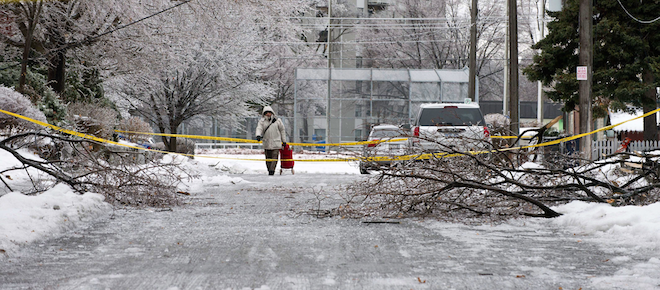Bad ice storm? Yes. Great Ice Storm? Not even close
Nasty as this may be, it’s nothing like 1998
Galit Rodan/CP
Share

Toronto, struggling to cope with massive power outages in the wake of a weekend ice storm, has called in reinforcements. No, not Canadian troops, who famously lent a hand when former mayor Mel Lastman requested military assistance after a particularly heavy snowfall in 1999. This time, it’s hydro crews from Ottawa and the United States who are in Toronto to help restore power to the hundreds of thousands of customers living in the dark. Many are expected to have no electricity until Boxing Day, and Red Cross volunteers and city officials have set up warming centres for those without heat. The messy recovery has drawn flashbacks to the Great Ice Storm of 1998, the devastating wallop that ravaged eastern Ontario, Quebec, and parts of upstate New York and Vermont for a week in January.
This week’s storm is a doozy, but comparisons to 1998 are probably premature. Unlike the Great Ice Storm of 1998, no municipality has yet declared a state of emergency—and, much to the chagrin of Canadians looking to poke fun at their largest city, no military boots are on the ground.
“Three weeks after that storm in 1998, there were still hundreds of thousands of people without power,” recalls Dave Phillips, senior climatologist at Environment Canada. “And here we¹re talking about perhaps not being able to cook a turkey at Christmas. It isn’t the same impact.”
The effects of last weekend’s storm, which stretched from Friday until Sunday, may be felt for up to a week. By contrast, 1998’s storm was actually a series of three major storms that comprised almost an entire week of near-continuous freezing rain from January 5 to January 10. The deluge led to 100 millimetres of accumulated ice in some areas, compared to just over 30 millimetres that fell on Ontario over the three-day span.
The two storms do share a common origin: weather events transpired to produce the icy aftermath. A high-pressure system in northern Canada caused north-easterly wind to drift across the province and “just hug the ground, like molasses flowing across the table top,” explains Phillips. Warm, moist air then moved in from in and around Texas. The warm air rose overtop the cold mass, and produced rain that froze as it fell to the ground. Even if the air wasn’t cold enough to freeze the rain drop entirely, semi-frozen drops shattered on cold pavement and spread into a thin veneer of ice.
“It’s the toughest ice that nature can produce,” says Phillips. “If you have to hit it with a hammer to break it, it’s much more potent, much more damaging than ice pellets.”
The two events also affected a similarly sized region. This year’s storm moved eastward from southern Ontario and into parts of New Brunswick, Nova Scotia and Prince Edward Island. The 1998 storm hit an area in between.
But that’s where the similarities end. This time around, the number of people affected and the extent of the damage are far less significant. About 35 people died in the 1998 storm, either in traffic accidents or from carbon monoxide fumes produced by propane generators. Nearly 16,000 troops assisted in the clearance of roads, evacuation of sick people, and delivery of transformers to pig and cattle farmers in rural areas. This week, two traffic fatalities have so far been blamed on icy roads in Ontario, and Red Cross volunteers are helping to operate warming centres in Toronto.
In 1998, more than 1.2 million residents were left without power compared to the approximately 500,000 hydro customers affected this week. Twelve thousand hydro poles had to be replaced in 1998, significantly more than the 23, as reported by Hydro One, that came down this weekend.
Significant upgrades to hydro equipment sparked by the 1998 storm has likely helped Ontarians weather the most recent storm.
“The 1998 Ice Storm taught Hydro One many lessons, spurred significant system augmentations, and improved our emergency response capabilities and communication processes,” says Tiziana Baccega Rosa, spokeswoman for Hydro One, which services 1.3 million customers in Ontario outside major cities, in large suburbs, and in rural areas.
Transformer towers that were collapsing and falling to the ground under the weight of the ice in 1998 were strengthened with materials to help them better withstand the weight. Hydro One also opened the Ontario Grid Control Centre in Barrie in 2004, which centralized transmission and distribution systems. In real time, crews can monitor data on a screen, such as line voltage irregularities caused by high winds. Another system helps them zoom into pictures of hydro poles and check their current conditions. Additionally, Hydro One embarked on an $82-million project to replace 11,000 poles this year.
The transmission system that brought people to their knees in 1998 held its own this week. The storm had a bigger impact on the distribution side of the hydro system, which delivers power from smaller sub-stations to residences.
Ice storms aren’t exactly rare, but neither are they common. An average winter sees about 17 hours of freezing rain in spurts, not the 50 hours received this weekend.
In 1968, Toronto and Hamilton both received a similar amount of freezing rain as this past weekend, and the downpour was followed immediately by nearly 30 centimetres of snow. That combination led to a lot of downed wires that fell victim to heavy layers of snow. The Toronto area experienced the largest ice storm of the last century before the 1998 disaster. A storm in 1959 lasted from Dec. 26-28, and left 125,000 customers without power. Eleven deaths were associated with that storm.